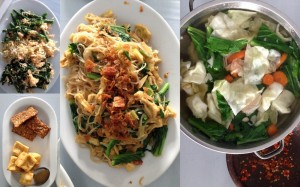The family had a long restful night. The evening had ended well, with foot reflexology massages for all and we cheerfully looked forward to the rest of our trip. Sam was in high spirits too. The local football team from Malang, Arema had won against Thailand and he was in a celebratory mood. It was a bright sunny day and we rejoiced in the sun as we stepped out to visit the Tugu monument right across the hotel. I don’t recall seeing so many pink lotuses in full bloom ever before. It was a beautiful sight.
We were driving onwards to Solo today and no sooner than we began our road trip, the weather turned cloudy, and wet with rains. In retrospect, we probably chose the wrong time to be in East Java – It was peak monsoon season. Nevertheless, monsoons made the whole landscape green and fresh and the fog and cloud added to the mystery and beauty of it all. And then there was ginger tea.
All through our drive we crossed road side warungs, small shops that sold, hot tea, cold bottled drinks, candy, cigarettes, snacks that sometimes doubled up as wartel or warnet depending on whether they offered a telephone or internet facility. We stopped for a photo shoot and some tea on our way at the town that was known for its green apple orchards. I have never seen an apple tree all my life and I was hoping to catch a glimpse of green apples on trees but the weather spoilt our chances. Our scheduled visit of a walk through an apple farm was literally washed out.
We were going to be on road for over 8 hours and we had to make the best of it. We enjoyed the country side that looked green with corn, sugarcane and rice fields for long stretches of land. It seemed to me that that the farmers in East Java were a happy lot. The highlight of our drive was our lunch at a town called Nganjuk. At first it looked like no one had stopped for lunch at that hotel for the day, but when they laid out our lunch I was impressed beyond words. We had explained to the chef of this bistro how we were vegetarians and that meant no shrimp, meat broth or eggs even (It is a big challenge for them to make a dish without a meat broth, shrimp paste or eggs) This is where I discovered the magical urap-urap. Sam did warn us that if we wanted to avoid fried food, then Java was the wrong place to be. Fried food is omnipresent in Javanese cuisine.
On our way Sam engaged us in interesting tit bits about Java. At some point in our conversation, we mentioned Maxx and wondered why we hadn’t spotted any dogs at all. Sam told us about the hadith and Quran and how Muslims strictly follow what the prophet has urged them to follow. I thanked my Indonesian helper at home a million times for she is fond of Maxx and will never ignore his needs.
I seldom miss noticing the various regional accents that creep into the way we speak English and with Sam it was no different. Many words he spoke took time and repeated listening, to understand. Those were the times I appreciated the effort it takes for people who speak English as first language to understand the way the rest of speak English, when it is not our first language.
Even though we were driving past large towns, the roads that connected these towns weren’t typically highway. It seemed to me that there were houses built on one side of the highway throughout, which meant shops, children, pedestrians, cyclists and two wheelers doing what they did best- randomly crossing of the road, riding too close to fast moving traffic. I even saw barefooted men who dashed across the road right in front of the commuter. As we drove by many shops and sign boards it was difficult to miss how many Indian sounding names I was noticing- Rajawati, Wijaya, Kartika, JayaSakti, Dewi, Kusuma, Poornama, Surya and Sri. Even the toilets have Indian names- Wanita for the ladies ‘room and Pria for the men! I asked Sam about the names and what he said about how boys and girls were named as infants I found interesting.
Most Javanese names for men ended with an O sound – largely because their alphabet, the Huruf Jawa had such sounds. So a Java is Javo, Bramha is Bromo and Siva is Sivo. You get the idea. Most Javanese have only one name without a surname. Now you know Sukarto, Sukarno and Susilo are Javanese names. Also boys are named after the most recent and big event happening around town at the time the baby was born. You will find many boys in Java that have been named after active volcanoes or something as mundane as the day of the week they were born. So it is likely that you will meet a Sinen, Suhlasa, Rabu, Khamis, Jummat, Sabtu, or Minngu which are also the names of the days of the week. Sam added that infant girls however are usually named after flowers or something as ‘genuine’ as that. I found out that Sam had two daughters and so I was curious what they were called. He had to enunciate and repeat the names thrice for me to note it down. Their first names were beautiful and would have made Steve Jobs proud. Irlanda Padmaningrum and Iloka TiktaPamunkaas.
We checked into the Novotel Solo before the evening was late. Akank spotted a beautiful digital piano in the lobby and instantly cheered up. Post dinner, she even gathered the courage to request that she play it and the hotel let her.















